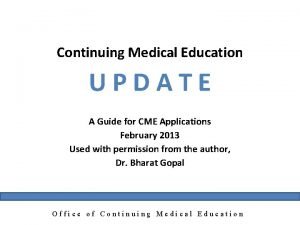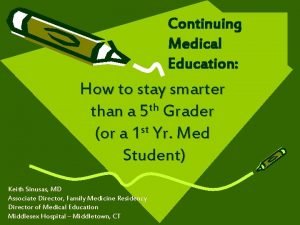Initial Results of a MultiFaceted Continuing Medical Education

- Slides: 1

Initial Results of a Multi-Faceted Continuing Medical Education Intervention Designed to Reduce Unnecessary Blood Transfusions Evangeline Arulruja, MS-III; David W. Musick, Ph. D; A. Paul Dallas, MD; Joshua Gazo, MD; Shari Whicker, Ed. D; Linda Wells, CHCP; Kari Vanblaricom Background • Red blood cell (RBC) transfusions are risky for some patients, as evidenced by: • Patient outcomes • Needless use of valuable resources • Unnecessary cost to patients and healthcare systems 1 -5 • A gap exists between clinical practice and evidence-based medicine • Research Question: can a multi-faceted Continuing Medical Education (CME) intervention impact physician transfusion practices? Methods • Study Period: Aug 2015 – Aug 2017 • Implemented a multi-faceted CME intervention: • Didactic presentations • Educational material online and hard copy • Posters • Electronic medical record clinical decision support • Collected baseline (12 months), intervention (12 months), and postintervention follow-up (6 months) data detailing transfusions ordered by Internal Medicine residents • Collected feedback from physicians about quality and effectiveness of CME intervention • Analyzed data using descriptive statistics and explored cost savings Results Background Discussion • 55 Internal Medicine (IM) Residents participated • Transfusion orders were reduced by 69% for a six month period during year one • Appropriate documentation of indications for transfusion orders increased by two-fold • Education materials were rated favorably • Reduction of $168, 550 in the cost of transfusing packed red blood cells • Decreased patient exposure to inherent risks associated with excessive transfusions Intervention impacted IM resident physician practice with regard to RBC transfusion, thus limiting patient exposure to risks associated with unnecessary RBC transfusions, preserving resources, and reducing costs Which Educational Intervention Motivated You to Change Your Transfusion Practices the Most? Didactic Presentation Online education materials Hard copy education materials Informational posters EPIC changes My practice was unchanged 36. 96% 19. 57% 10. 87% 6. 52% 2. 17% 23. 91% Sample Knowledge Test Questions Conclusions • A multi-faceted, targeted CME intervention was well-received and had a dramatic impact on the RBC transfusion practices of the IM resident physicians. • Achieved both increased clinical documentation and reduction in ordering of excessive transfusions • Further study is needed to determine long-term impact of CME intervention on physician practice and associated patient outcomes References 1. Corwin, H. L. , et al. (2014). "Red blood cell transfusion: impact of an education program and a clinical guideline on transfusion practice. " J Hosp Med 9(12): 745 -749. 2. Carson JL, Carless PA, Hebert PC. Transfusion thresholds and other strategies for guiding allogeneic red blood cell transfusion. Cochrane Database Syst Rev. 2012; 4: CD 002042. 3. Marik PE, Corwin HL. Efficacy of RBC transfusion in the critically ill: a systematic review of the literature. Crit Care Med. 2008; 36: 2667– 2674. 4. Shander A, Fink A, Javidroozi M, et al. Appropriateness of allogeneic red blood cell transfusion: the International Consensus Conference on Transfusion Outcomes. Transfus Med Rev 2011; 25: 232 -46. 5. Salpeter, S. R. , et al. (2014). "Impact of more restrictive blood transfusion strategies on clinical outcomes: a meta-analysis and systematic review. " Am J Med 127(2): 124 -131 e 123.

